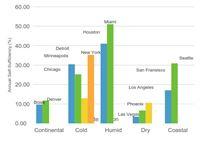Feasibility of Rainwater Harvesting in US

This paper assesses the climatic feasibility of water self-sufficiency of buildings that employ rainwater harvesting. The feasibility of standard single-family residential buildings that employ rainwater harvesting in thirteen cities that represent a range of climatic regions across the continental U.S. were assessed. Using the water consumption data published by the United States Geological Survey (USGS) and the American Water Works Association (AWWA), the quantities of current water consumption in typical American households with the average population of 2.58 residents were analyzed. Using the NOAA 30-year average precipitation data, the volumes of rainwater that can be harvested from the rooftop catchment areas of standard two-story single-family homes in the test-bed cities were estimated. Comparing the volumes of water consumption and harvested rainwater, the water self-sufficiencies of the test homes were analyzed.
keywords: Rainwater Collection, Water Self-Sufficiency, Water Conservation


Add comment
Log in to post comments